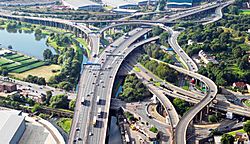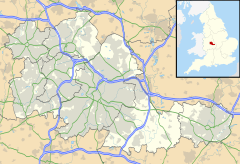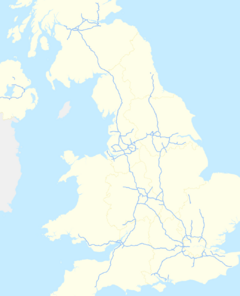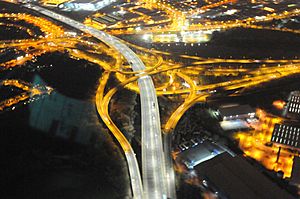Spaghetti Junction, Birmingham facts for kids
Quick facts for kids Gravelly Hill Interchange |
|
|---|---|

Gravelly Hill Interchange from the south east
|
|
| Spaghetti Junction | |
| Location | |
| Birmingham, England | |
| Coordinates: | 52°30′40″N 1°51′58″W / 52.511°N 1.866°W |
| Roads at junction: |
|
| Construction | |
| Type: | Free-flow interchange |
| Opened: | 24 May 1972 |
| Maintained by: | National Highways |
| Map | |
| Lua error in Module:Infobox_road/map at line 15: attempt to index field 'wikibase' (a nil value). | |
The Gravelly Hill Interchange is a famous road junction in Birmingham, England. Most people know it as Spaghetti Junction. It's where the M6 motorway (at junction 6) connects with the A38(M) Aston Expressway. This huge junction opened on May 24, 1972. It helps cars get on and off several important roads in the Gravelly Hill area.
Contents
What is Spaghetti Junction?
This amazing junction connects many different roads. It links the A38, the A38(M) (Aston Expressway), and the A5127. It also connects to several smaller local roads. The whole area it covers is about 30 acres.
It has 18 different routes for traffic. There are 4 kilometers (2.5 miles) of special slip roads. These roads help cars move from one motorway to another. Only 1 kilometer (0.6 miles) of the M6 motorway itself is part of the junction.
How it was Built
The junction has five different levels. It stands on 559 concrete columns. Some of these columns are as tall as 24.4 meters (80 feet). Engineers had to build 21.7 kilometers (13.5 miles) of motorway high up in the air. This was done to go over two railway lines, three canals, and two rivers.
In 1958, the Ministry of Transport asked engineers to plan the roads. They wanted to connect the M6, A38(M), and A38 roads.
How it Got its Name
The nickname "Spaghetti Junction" was first used in 1965. Journalists from the Birmingham Evening Mail came up with it. A reporter named Roy Smith said the plans looked like "a cross between a plate of spaghetti and an unsuccessful attempt at a Staffordshire knot". His editor, Alan Eaglesfield, then used the headline "Spaghetti Junction". This fun name later became popular for other complex road junctions around the world.
Building the Junction
The plan to build the interchange was approved in August 1968. The Minister of Transport, Richard Marsh, announced it. The building work was expected to take three years. It was also expected to cost about £8 million. Roy Foot was the main engineer in charge of the project.
Challenges and Protests
There were some objections to the construction. One group wanted to "save our fish". They wanted to move a quarter of a million fish from a pool that would be removed. Another rule was that the canal towpaths under the junction had to be tall enough for horses to pass.
Most of the work was finished by May 1970. Local people were very interested in the project. By September, some drivers were already using the unfinished roads illegally. Children even found it a useful shortcut to school!
The Grand Opening
The junction officially opened on May 24, 1972. Peter Walker, who was a government minister, opened it. The opening was delayed for several months. This was because of safety checks on "box girder bridges". These checks happened after similar bridges collapsed in Australia and Wales.
Birmingham City Council thought the junction could attract visitors. They even suggested holding a Grand Prix race on the interchange!
Keeping it in Good Shape
Spaghetti Junction has needed major repairs many times. This is because a lot of traffic uses it every day. Also, some money-saving choices were made when it was first built.
In 2007, a slip road had to close for urgent repairs. Workers found that salt and grit had weakened parts of the structure. By 2009, over a billion vehicles had driven through the junction. Even with some problems, the structure was still strong enough for traffic.
South-east of the junction, the M6 motorway is on the Bromford Viaduct. This is the longest viaduct (a long bridge-like structure) in the UK.
What's Underneath?
Underneath the huge motorway junction, many other things meet. Local roads cross paths there. The River Tame meets the River Rea and Hockley Brook. The Cross-City Line and Walsall railway lines also run below. And at Salford Junction, three canals meet: the Grand Union Canal, the Birmingham and Fazeley Canal, and the Tame Valley Canal. It's a busy place, both above and below ground!





